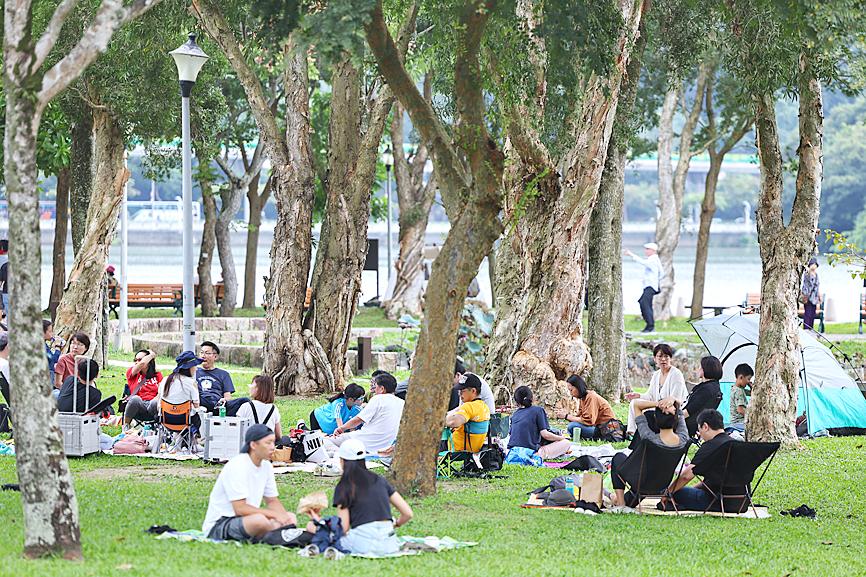Increasing green space coverage in an area by 1 percent is associated with a 0.2 percent drop in the suicide rate, a study by a team at National Cheng Kung University (NCKU) in Tainan said.
The study on the possible correlation, led by the university’s Department of Geomatics professor Wu Chih-da (吳治達), was recently published in the academic journal Landscape and Urban Planning, the university said in a press release yesterday.
The team used figures from the National Health Insurance database on the number of suicides in Taiwan’s 368 townships from 2000 to 2018 and then used geographical and satellite data to measure the amount of green space — mainly parks and school campuses — in each of the townships.

Photo: CNA
Using the spatial pattern analysis software Fragstats, the team quantified the data based on several indices for green space, including land area, shape and proximity to people.
The researchers also had to normalize the data by taking into account other factors known to affect the suicide rate, such as age, sex, economic circumstances, education and level of urbanization, Wu said.
For example, historical data show that rural areas in Taiwan have a higher suicide rate than urban areas, despite typically having more access to green space, he said.
However, that phenomenon is driven by other factors affecting the suicide rate, and therefore had to be adjusted for the effects of green space to be accurately analyzed, he said.
The study concluded that long-term exposure to green space — particularly green space that is greater in size, simpler in shape and closer in proximity to people — is associated with a decreased suicide risk.
In quantifiable terms, it found that increasing green space coverage by 1 percent in an area is associated with a 0.2 percent drop in the suicide rate.
In other words, in an area that had 1,000 suicides over a 10-year period, increasing green space coverage by 1 percent could reduce the number of suicides to 998.
Wu said he hoped the study would be useful to urban planners in government, particularly those in cities, which have to contend with high property values and a general lack of open space.
In such circumstances, even small projects, such as stitching together several small plots of land to create a green corridor, can have beneficial effects on residents’ psychological health, he said.

South Korean K-pop girl group Blackpink are to make Kaohsiung the first stop on their Asia tour when they perform at Kaohsiung National Stadium on Oct. 18 and 19, the event organizer said yesterday. The upcoming performances will also make Blackpink the first girl group ever to perform twice at the stadium. It will be the group’s third visit to Taiwan to stage a concert. The last time Blackpink held a concert in the city was in March 2023. Their first concert in Taiwan was on March 3, 2019, at NTSU Arena (Linkou Arena). The group’s 2022-2023 “Born Pink” tour set a

The Sports Administration yesterday demanded an apology from the national table tennis association for barring 17-year-old Yeh Yi-tian (葉伊恬) from competing in the upcoming World Table Tennis (WTT) United States Smash tournament in Las Vegas this July. The sports agency said in a statement that the Chinese Taipei Table Tennis Association (CTTTA) must explain to the public why it withdrew Yeh from the WTT tournament in Las Vegas. The sports agency said it contacted the association to express its disapproval of the decision-making process after receiving a complaint from Yeh’s coach, Chuang

The Taiwan High Court yesterday upheld a lower court’s decision that ruled in favor of former president Tsai Ing-wen (蔡英文) regarding the legitimacy of her doctoral degree. The issue surrounding Tsai’s academic credentials was raised by former political talk show host Dennis Peng (彭文正) in a Facebook post in June 2019, when Tsai was seeking re-election. Peng has repeatedly accused Tsai of never completing her doctoral dissertation to get a doctoral degree in law from the London School of Economics and Political Science (LSE) in 1984. He subsequently filed a declaratory action charging that

The Hualien Branch of the High Court today sentenced the main suspect in the 2021 fatal derailment of the Taroko Express to 12 years and six months in jail in the second trial of the suspect for his role in Taiwan’s deadliest train crash. Lee Yi-hsiang (李義祥), the driver of a crane truck that fell onto the tracks and which the the Taiwan Railways Administration's (TRA) train crashed into in an accident that killed 49 people and injured 200, was sentenced to seven years and 10 months in the first trial by the Hualien District Court in 2022. Hoa Van Hao, a